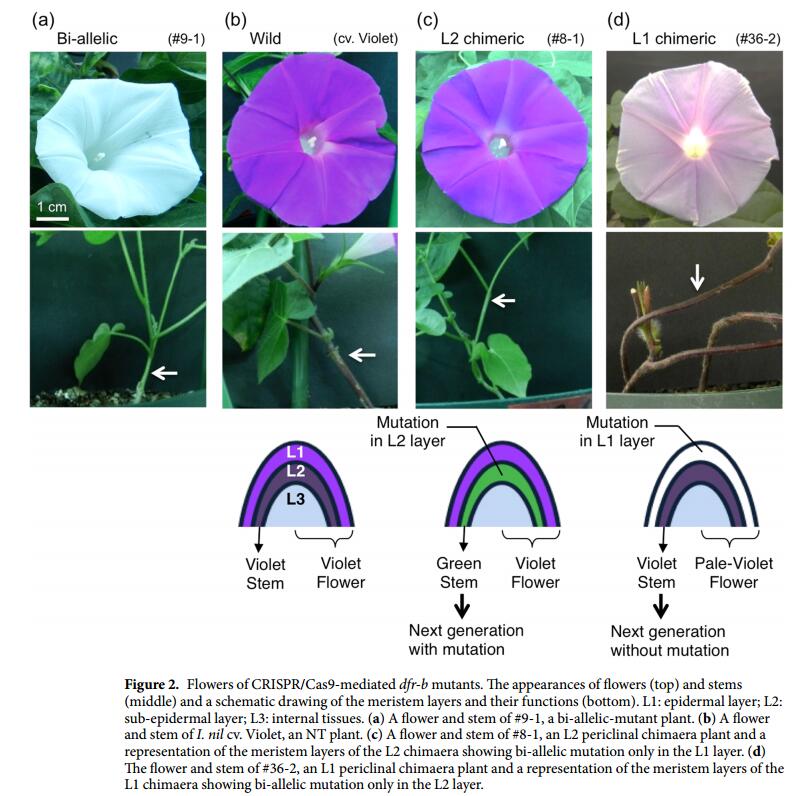博文
基因编辑技术用于改变花的颜色!
||
Crispr-Cas9基因编辑技术用于改变花的颜色!CRISPR基因编辑技术是当前最常采用的基因敲除方法,Dihydrofavonol-4-reductase-B(DFR-B)是牵牛花中负责花瓣颜色的基因,该基因编码的酶的其活性丧失会导致花瓣颜色变白。最近,研究人员利用该技术敲除了DFR-B基因,75%的Crispr-Cas9基因编辑的牵牛花开出了白花。相关研究结果发表在《Scientific Reports》杂志上(CRISPR/Cas9-mediatedmutagenesis of the dihydroflavonol-4-reductase-B (DFR-B) locus in the Japanesemorning glory Ipomoea (Pharbitis) nil.),具体细节请参阅原文。



新闻原文:We've never seen the CRISPR gene-editing tool used like this before. Scientists have turned a Japanese garden plant from violet to white by disrupting a single gene - yet more evidence of the huge potential that CRISPR holds.
The modified flower is the Japanese morning glory plant, with researchers targeting only the gene responsible for flower colour without affecting the rest of the plant. But the potential here goes far beyond the cosmetic. If you're new to CRISPR/Cas9 - the Cas9 enzyme is responsible fordoing the DNA cutting - it lets scientists cut and paste genes with incredible precision, allowing for some pretty deep biological engineering. While many are concerned about how these tools could be misused, they could also do a lot of good.
We've already seen it used to edit out genes causing disease inanimals, though there are ethical questions about its possible future use inhumans. Now this team, from institutions across Japan, says the CRISPR/Cas9 technique is going to make a huge difference in the study and manipulation of plants. "To our knowledge, this report is the first concerning flower colour changes in higher plants using CRISPR/Cas9 technology,"writes the team of researchers.
The morning glory plant was chosen for this particular experiment as it's already part of the National BioResource Project (NBRP) in Japan – that means scientists already know a lot about its genetic coding, andthe DNA blueprints are already available. The team targeted the gene responsible for the colour of the plant's flowers, thedihydroflavonol-4-reductase-B (DFR-B) gene. With two other very closely relatedgenes sitting either side of DFR-B, the challenge was to use CRISPR/Cas9 tosnip out the right DNA strands very specifically without affecting the rest of the plant. The enzyme produced by DFR-B is known to be responsible forproducing the colour pigmentanthocyanin,so shutting it off should turn the flowers white – and so it proved.
Around 75 percent of the treated plant embryos grew up to flower with white rather than violet petals, and further analysis of the neighbouring genes showed nomutations, a testament to the accuracy of CRISPR/Cas9. The study has consequences beyond potentially enabling you to colour your flower beds toorder, because some of the next generation of plants – which also grew up with white flowers – showed no signs of the artificially introduced DNA.
That raises interesting questions about how our newly found geneediting powers could permanently change the course of nature, no matter how good or bad our intentions. For now though, the scientists are promoting theirstudy as a way of showing the accuracy and the potential of CRISPR/Cas9: the morning glory plant was introduced to Japan in the 8th century AD, and itwasn't until the 17th century that a white version appeared as the result of agenetic mutation.
What nature took around 850 years to achieve, CRISPR/Cas9 managed in less than 12 months, and that's both exciting and a little scary. "The successful results of the present study willfacilitate the modification of flower colours and shapes with targetedmutagenesis inIpomoea niland other ornamental flowers orvegetables," conclude theresearchers.
https://m.sciencenet.cn/blog-3319332-1075900.html
上一篇:20170914——倒挂金钟(Fuchsia hybrida Hort. ex Sieb. etVoss
下一篇:20170915——月见草(Oenothera biennis)